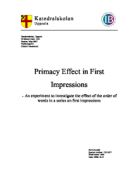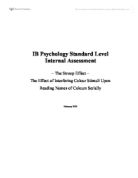Solomon E. Asch (1946) showed in his experiment how the organisation of words in a series of traits that describe an imaginary person affects individuals in their overall impression of that person. Asch described a person to a sample group using a list of adjectives. He described the person as intelligent, industrious, impulsive, critical, stubborn and envious. To another sample group, the person is described as envious, stubborn, critical, impulsive, industrious and intelligent. The traits listed to both groups were the same, but their order reversed, with one group heard positive traits first and the other negative traits first. By assessing the two groups’ answers on a questionnaire, where the participants marked a number of positive traits that they thought fit the person described to them The participants marked more traits suitable for the person if they had heard the series with positive traits placed first. Asch’s study suggests that if positive things are placed first in a description, then they dominate the whole portrayal which results in an overall positive impression and vice versa. The study is therefore key in describing how the formation of first impressions works and has been part in supporting the primacy effect theory which makes it worthwhile replicating.
This experiment was a replication of Asch’s study. The aim of this experiment will therefore be to see if the position of words in a series affects the first impression people get of a person described to them.
Method
Design
The experiment was of an independent sample type, where the independent variable was manipulated in two groups of participants, and the dependant variable was measured in both groups. The independent sample design was used, so that the participants would not be biased from their impressions of the first description. The participants were given consent forms which explained that they had the rights to withdraw, that their results were confidential and their anonymity protected. The experiment was not conducted so it would demean the participants in any way. The participants were debriefed, and their results were available to them after the experiment.
Independent Variable: The order of the traits in the series.
Dependant Variable: The number of positive traits that the participants marked on the questionnaire
Participants
The sampling method used was opportunity sampling, which was used because the groups were already formed as school classes and were easily available to the researcher. The participants were 1st year students of a Swedish upper secondary school and were of ages 15-16. They had mixed ethnic and cultural backgrounds, but a majority were ethnic Swedes. The groups had predominantly female participants as showed in Table 1.
Table 1, Gender Distribution
Apparatus/Materials
The material used in the experiment was consent forms and a questionnaire.
Procedure
First of all, a questionnaire was constructed. The main part was replicated from Asch’s. Then the researcher began the experiment, and started with explaining to the participants in Group 1 that they were to hear a series of traits that describe a person, and that they were going to mark other traits on a questionnaire if they thought those traits fit the person described to them. Then they were informed of their right for withdrawal and were handed consent forms. A series of traits were read out loud to the participants that signed the consent forms. The traits were:
Intelligent, hard-working, impulsive, critical, stubborn and jealous.
Then the participants were given questionnaires that they filled in according to the instructions previously given by the researcher. The group was then vocally debriefed. The procedure was repeated with Group 2 at a later date, but the order of the traits in the series was reversed. The traits were:
Jealous, stubborn, critical, impulsive, hard-working and intelligent.
Results
The results obtained from the questionnaires were calculated into percentage of total number of participants, as the two groups were not of the same size. The results were as follows:
Graph 1, Percentage of participants in Group 1 who chose a trait
Graph 2, Percentage of participants in Group 2 who chose a trait
As the graphs illustrate there is a lesser percentage of traits marked in Group 2, than in Group 1.
Table 2, Calculations of central tendency in %
The central tendencies (median, mode and mean) in Group 2 are smaller than those in Group 1.
Table 3, Range in percentile difference between lowest and highest percentage of students who chose a trait
Group 1 has a slightly broader, more varied result than Group 2.
Discussion
The results show that a less percentage of participants in Group 2 gave the person described positive attributes than in Group 1. The calculation of central tendencies, especially the median and the mode, shows the difference between the two groups. Group 1 marked on average more traits than Group 2. Also, in Group 1 all traits were marked by at least one participant, which is in contrast to Group 2 where traits that had zero marks were most dominant, as presented by the mode. In Group 1, there is an anomalous trait, persistent, that 100% of all participants have chosen, while a large percentage of participants (82.60%) in Group 2 also chose the trait it was unexpected that the group would reach consensus on even one trait. Overall the result was expected, and the figures are similar to those in Asch’s study.
The results suggest that the participants in the experiment were influenced by the primacy effect when forming their impression of the person described to them and that seemed to cause the participants not only to allot more traits to the person described, but assign a wider range of traits to him. While the study that was replicated does explain the result satisfactorily it does not take into account the recency effect into account. Other studies on the subject of the recency effect would be appropriate to more fully explore the formation of first impression. Researching primacy effect from an evolutionary bio-psychological perspective as a skill that has survival value would also provide more information to the topic. Also, more studies that have similar method to this one, albeit with different situations, such as impressions of capability in sport or academia instead of personality would enrich the subject further. To enhance the understanding of first impressions and the effect of initiate description on secondary impression, studies on stereotypes should be investigated.
The methodology could be improved by standardizing the entire experiment. As the researcher may act, or speak differently in different sample groups, pronounce a word wrong, or stutter while speaking etc. it would be prudent to do a voice recording that lists the traits. Also, highly educated sample groups could be used to ensure full understanding of the meaning of words, as other less educated sample populations might need explanations for the hard words in the experiment, which might produce a skewed primacy/recency effect. Uncontrollable variables from the participants such as tiredness, attention and motivation could have affected the results. Drowsiness could hamper the participants’ ability to comprehend and process the information and make accurate judgements. Lack of attention could make a participant miss certain parts of the series of traits read to them and affect their judgement. These are just examples of numerous situations which could occur due to the participants’ mood or state. Stricter control over participant behaviour before the experiment would solve the problem, but that might cause ethical questions to arise. Slight bias might also be present in the experiment, as a questionnaire is used. Due to the nature of questionnaires there is a limited number of options available which therefore limits the response of the participants. However, the strength in the use of a questionnaire is that it is more probable to give a more thorough and workable result. If the participant would assign traits to the person themselves, they might not think of any. Therefore, the strength of the questionnaire is greater than its weakness. The major confounding variable in the experiment was the different number of participants in each sample group. Even though the problem was lessened by the use of percentage calculations instead of score it was not entirely eliminated, and did therefore have effect on the overall result. An equal number of participants in each group would make the result more valid
Conclusion
The sample group which heard the list of traits with positive traits placed first selected more traits on the questionnaire. The aim is reached, and it can be concluded that the position of words in a series does affect the first impression people get of a person described to them, and the traits placed first in the list affects the entire impression.
Bibliography
Asch, Solomon E. “Forming Impressions of Personality”, Journal of Abnormal and Social Psychology, 41, 1946, 258-290
Passer, Michael W. with Smith, Ronald E. Ed. Thalia Dorwick. Psychology – The Science of Mind and Behavior, Second edition, McGraw-Hill, New York, 2004, 594
As defined in: Passer, Michael W. with Smith, Ronald E. Psychology – The Science of Mind and Behavior, Second edition, 594
Asch, S. E. “Forming Impressions of Personality”, Journal of Abnormal and Social Psychology, 41, 258-290
See Appendix #1, Copy of Consent Form Used, i
See Appendix #2, Copy of Questionnaire Used, ii
See Appendix #3, Questionnaire Results, iii
See Appendix #4 and #5, Calculations of Results for Group 1 and Calculations of Results for Group 2







